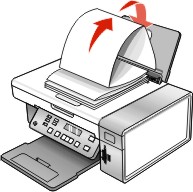100 sheets of plain paper | The paper is designed for use with inkjet printers. The paper is loaded in the center of the paper support. The paper guides rest against the edges of the paper.
|
25 sheets of heavyweight matte paper 25 sheets of photo paper 25 sheets of glossy paper | The glossy or printable side of the paper faces you. (If you are not sure which side is the printable side, see the instructions that came with the paper.) The paper is loaded in the center of the paper support. The paper guides rest against the edges of the paper.
Note: Photos require more drying time. Remove each photo as it exits, and allow it to dry to avoid ink smudging. |
10 envelopes | The print side of the envelopes faces you. The stamp location is in the upper left corner. The envelopes are designed for use with inkjet printers. The envelopes are loaded in the center of the paper support. The paper guides rest against the edges of the envelopes. Warning: Do not use envelopes that have metal clasps, string ties, or metal folding bars. Notes: - Do not load envelopes with holes, perforations, cutouts, or deep embossing.
- Do not use envelopes that have exposed flap adhesive.
- Envelopes require more drying time. Remove each envelope as it exits, and allow it to dry to avoid ink smudging.
|
25 sheets of labels | The print side of the labels faces you. The top of the labels feeds into the printer first. The adhesive on the labels does not extend to within 1 mm of the edge of the label. You use full label sheets. Partial sheets (with areas exposed by missing labels) may cause labels to peel off during printing, resulting in a paper jam. The labels are loaded in the center of the paper support. The paper guides rest against the edges of the labels.
Note: Labels require more drying time. Remove each sheet of labels as it exits, and allow it to dry to avoid ink smudging. |
50 transparencies | The rough side of the transparencies faces you. If the transparencies have a removable strip, each strip faces away from you and down toward the printer. The transparencies are loaded in the center of the paper support. The paper guides rest against the edges of the transparencies.
Notes: - Transparencies with paper backing sheets are not recommended.
- Transparencies require more drying time. Remove each transparency as it exits, and allow it to dry to avoid ink smudging.
|
10 iron-on transfers | You follow the loading instructions that came with the iron-on transfers. The print side of the transfers faces you. The transfers are loaded in the center of the paper support. The paper guides rest against the edges of the transfers.
Note: For best results, load transfers one at a time. |
25 greeting cards 25 index cards 25 photo cards 25 postcards | The print side of the cards faces you. The cards are loaded in the center of the paper support. The paper guides rest against the edges of the cards.
Note: Photo cards require more drying time. Remove each photo card as it exits, and allow it to dry to avoid ink smudging. |
100 sheets of custom-size paper | The print side of the paper faces you. The paper size fits within these dimensions: Width: 76.2–215.9 mm 3.0–8.5 inches
Length: 127.0–355.6 mm 5.0–17.0 inches
The paper is loaded in the center of the paper support. The paper guides rest against the edges of the paper.
|
20 sheets of banner paper | You remove all the paper from the paper support before loading the banner paper. You tear off only the number of pages needed to print the banner. You place the required stack of banner paper on the top cover. The leading edge of the banner paper feeds into the printer first. The paper is loaded in the center of the paper support. The paper guides rest against the edges of the paper.
|


